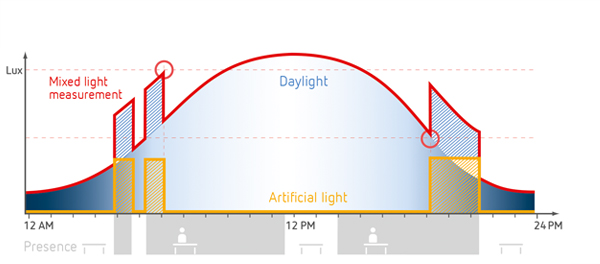
Light measurement with presence detectors: Constant light control or mixed light measurement?
Lighting control using presence detectors is based on detected movement on the one hand and on light measurement on the other. Presence detectors permanently measure the brightness inside the room. Through this permanent light measurement, the presence detector is able not only to switch on artificial light when there is not enough daylight, but also to switch it off again when there is sufficient daylight. It sounds very easy, but in fact the presence detector must be able to assess, whether there is enough daylight after switching off the artificial light.
Switching operation
During switching operation, the presence detector measures the sum of artificial lighting and daylight. In order to be able to switch off the artificial light at the right moment when there is increasing daylight, the presence detector must know the proportion of artificial light (see fig.). This value is automatically learned by the detector by constantly analysing the lighting switching processes in the room. This enables it to calculate the current daylight intensity at any time from the measured total brightness. The advantage of mixed light measurement is that it works with any light source – whether LEDs, halogen or fluoret cent lamps. Mixed light measurement is the base for constant light control.
Constant light control
With constant light control, the presence detector permanently measures the sum of daylight and artificial light (see fig.). It determines the desired brightness value from these two light sources. On a misty or rainy morning the available daylight is less. In this case, the presence detector increases the proportion of artificial light, in order to reach the desired brightness in the room. If the sun breaks through in the course of the morning and there is increased light through the windows, the presence detector reduces the proportion of artificial light. The brightness level in the room therefore remains constant, regardless of the incidence of daylight. Typical applications: Production buildings where a specific brightness level is required by law.


